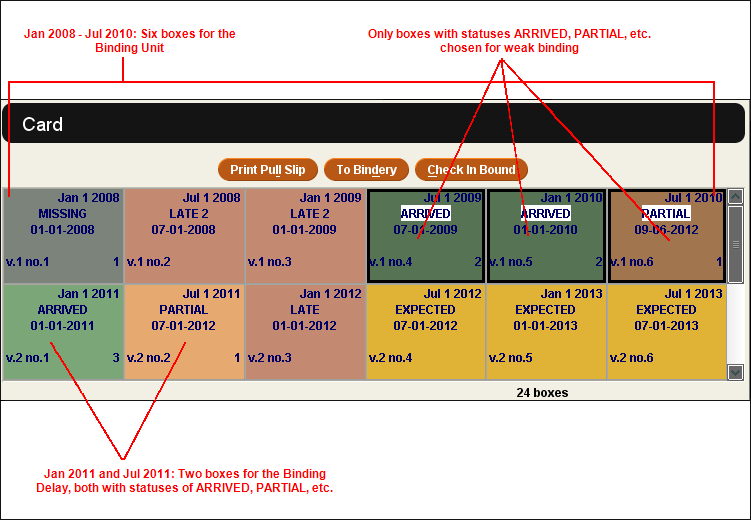Determining Which Issues to Bind
Sierra uses one of two methods to determine which issues, supplements, and indexes are eligible for binding:
Each method uses the Binding delay, Unit of binding, and Status fields in the checkin card to determine which issues are bindable. See Overview of Checkin Card Fields for more information on these fields.
Weak Binding
By default, Sierra uses the Enable Weak Binding option, employing a less stringent method of determining which issues, supplements, and indexes are bindable.
The system searches for a bindable range in which:
- at least one of the boxes has a Status of "ARRIVED", "PARTIAL", "TO BIND", "BIND PREP", or "BOUND" (note that the box with a Status of "BOUND" will only be selected if the number of copies already bound is less than the total number of copies for the serial)
- all of the boxes in the Binding delay also have a Status of "ARRIVED", "PARTIAL", "TO BIND", "BIND PREP", or "BOUND"
If all conditions are true, the system considers the boxes in the Unit of Binding with the statuses of "ARRIVED", "PARTIAL", "TO BIND", "BIND PREP", and "BOUND" to be bindable.
For example, the following checkin card has a Unit of binding of '6' and a Binding delay of '2'.

The bindable range (Jan 2008 to Jul 2010) has at least one issue with a Status of "ARRIVED", "PARTIAL", "TO BIND", "BIND PREP", or "BOUND". Specifically, the Jul 2009 and Jan 2010 issue statuses are "ARRIVED", and the "Jul 2010" issue status is "PARTIAL".
The Jan 2011 and Jul 2011 issues fulfill the requirement that the Binding delay boxes also have a Status of "ARRIVED", "PARTIAL", "TO BIND", "BIND PREP", or "BOUND". These boxes have statuses of "ARRIVED" and "PARTIAL", respectively.
Therefore, Sierra selects the Jul 2009, Jan 2010, and Jul 2010 issues as bindable; the Jan 2008 through Jan 2009 issues are not bindable because they have statuses of "MISSING" and "EXPECTED" (boxes that display as "LATE" actually have a Status of "EXPECTED").
Standard Binding
NOTE
To mark issues as bindable according to the "standard" binding method, the Enable Weak Binding option must be disabled in the Setup tab .
The "standard" binding method searches for a bindable range in which:
- all of the issues, supplements, and indexes have a Status of "ARRIVED" or "PARTIAL".
When the system searches for a bindable range, it looks for an ending issue number which is evenly divisible by the Unit of binding established in the checkin card parameters.
- all of the issues, supplements, and indexes in the Binding delay have a Status of "ARRIVED" or "PARTIAL".
If all conditions are true, the boxes in the range are considered bindable.
For example, a card has a Unit of binding of '6', a Binding delay of '1', and contains the following range:

There are six issues, numbered 7841 through 7846, in the range. Issue 7847 appears to be the binding delay issue. However, 7846 is not evenly divisible by the Unit of binding (six), and therefore the system does not recognize this as a bindable range. The system will find a Unit of binding (bindable range) for this card only after the box for 330:7849 is checked in (because 7848 is divisible by six, and issue 7849 is the Binding delay issue).
The first issue of a bindable range is not necessarily the first box on a card. It is the first issue of a volume, or, if one volume is bound in multiple parts, it is the issue that begins a part. For example, if a title has eight issues per volume, but the Unit of binding is '4', the first issues are vol. 5:1 and vol. 5:5.